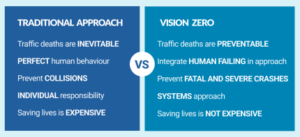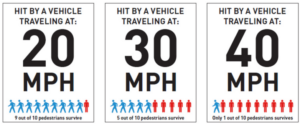
August is National Traffic Awareness month, and a perfect time to share the origins of one of today’s successful safety programs: Vision Zero.
The National Highway Traffic Safety Administration revealed that about 42,800 people were killed in auto accidents in 2022. This amounts to over 100 deaths per day in the U.S. If more cities were to adopt the tenets of Vision Zero, many of these accidents can be avoided.
What is Vision Zero?
Vision Zero is a traffic safety program with the goal of eliminating all fatal and severe accidents. The goal is to prevent a crash from occurring in the first place. This approach challenges the traditional views on accidents.

Image: Vision Zero
Although mistakes while driving are inevitable, these mistakes should not result in serious injuries or death. With the use of speed management and roads designed for pedestrian and roadway safety, the severity of accidents can be reduced. As the name suggests, the ultimate goal of Vision Zero is zero transportation-related injuries.
When did Vision Zero begin?
In the 1990s, Sweden created a Vision Zero policy. This traffic safety program had great success. From 2000 to 2010, the number of deaths from car accidents decreased by 60%. Following Sweden’s lead, other European countries and areas in the United States have implemented Vision Zero policies.
How will these changes improve our roads?
Vision Zero is a non-traditional approach to traffic safety. Rather than relying on individuals to drive perfectly all the time, Vision Zero integrates human failings into infrastructure design.
Because the most important factor in the severity of a crash is speed, speed management systems can be used to maximize safety. Physical barriers such as roundabouts and speed humps can deter drivers from speeding up in areas where there is pedestrian traffic.

Image: Seattle Department of Transportation
What cities in the United States have this program?
In the U.S., over 45 cities have implemented Vision Zero policies. Some include:
- Austin, TX
- San Francisco, CA
- Denver, CO
- Washington, D.C.
- Orlando, FL
- Boston, MA
- New York City, NY
- Philadelphia, PA
- Seattle, WA
- Richmond, VA
Vision Zero in Richmond
In 2015, the city of Richmond experienced 11 fatalities and 179 severe injuries due to car accidents. In March 2016, the city adopted a Vision Zero plan. Thus far in 2023, only 4 people have been killed and 37 have been severely injured, though the year is more than halfway over.
Mayor Levar Stoney has also pledged that Richmond will participate in the Safe and Healthy Streets challenge. In his blueprint, he lays out the plan for Richmond to reach zero severe injuries and deaths. His policies involve political commitment, data, and action, among other important components. With the commitment to a Vision Zero plan, Richmond has enjoyed progress with safety measures and will hopefully continue to strengthen its safety policies.



